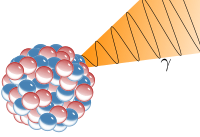
Photo from wikipedia
Abstract The aim of this study was to investigate the effect of X-ray irradiation in reducing the population of Salmonella Typhimurium, Escherichia coli O157:H7, and Listeria monocytogenes in ready-to-eat (RTE)… Click to show full abstract
Abstract The aim of this study was to investigate the effect of X-ray irradiation in reducing the population of Salmonella Typhimurium, Escherichia coli O157:H7, and Listeria monocytogenes in ready-to-eat (RTE) sliced ham and to verify the mechanisms underlying the lethal effect of X-ray irradiation. In addition, the effect of the X-ray treatment on food quality was determined by measuring color and texture changes. Sample surfaces were inoculated with cocktails of three pathogens and subjected to X-ray irradiation, with doses ranging from 0.2 to 0.8 kGy. After 0.8 kGy of X-ray irradiation, the numbers of S. Typhimurium , E. coli O157:H7, and L. monocytogenes were reduced by 5.7, 7.2, and 6.9 log CFU/g, respectively, without generating sublethally injured cells with potential to recover. The mechanism of X-ray-associated lethality was determined using fluorescent staining. We confirmed that the primary factors contributing to the lethal effect of X-ray treatment are related to intracellular enzyme inactivation and damage to cellular DNA rather than disruption of the cell membrane. Following X-ray irradiation, color values and textural characteristics of sliced ham products were not significantly altered compared to that of the control. The results of this study suggest that X-ray irradiation can be potentially used as a novel non-thermal process for inactivating foodborne pathogens in post-packaged RTE deli food products without compromising product quality.
Journal Title: Food Control
Year Published: 2019
Link to full text (if available)
Share on Social Media: Sign Up to like & get
recommendations!